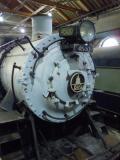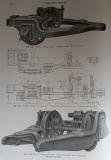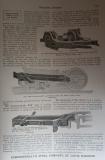
| Home | Open Account | Help | 282 users online |
|
Member Login
Discussion
Media SharingHostingLibrarySite Info |
Steam & Excursion > Front End Friday, Steam Edition: A B&O MacArthurDate: 04/26/24 05:19 Front End Friday, Steam Edition: A B&O MacArthur Author: bandob #4500 at the B&O Museum in Baltimore, Md in 2010. This was the first of the standard 2-8-2 Mikados under the United States Railroad Administration when the govenment took over railroad production during World War I. Baldwin built it in 1918. During WW II, the B&O felt it more patriotic to call the 2-8-2s "MacArthurs."
B&O Bill  Date: 04/26/24 08:20 Re: Front End Friday, Steam Edition: A B&O MacArthur Author: wcamp1472 RRs and loco builders were first beginning to comprehend
the importance of improved grate areas and firebox volumes. Once they experienced the improved performance derived by superheating, they gradually began to comprenand the distinction between pounds per square inch and steam at superheated temperatures. Every inch of expansion in the cylinders, causes the steam temperature to drop, and a greater portion returns to the liquid state of water. Steam at 250 psi is a little over 400F Superheating to steam temps over 600F, keeps heat of expansion powering the piston all the way down the stroke, and steam at lower pressure can still be superheated ( at lower superheat temps) as it blasts up the exhaust passages, to the stack. Heat-Saturated ( non-superheat) steam at the end of its expansion in the cylinders will be approaching 240F and dropping, over 50% is water vapor, before blasting into the sky. Steel casting for large shapes was still in its infancy. The first wide-use of steel castings was PRR's development of the cast trailer truck frames first used on the E-6 Atlantics, 4-4-2, developed in 1913. The casting was strengthened and applied to the L1, 2-8-2, K4, 4-6-2, up to the M1, 4-8-2s. Lima's first attempts at a 4-wheel trailer truck proved the be an inadequate solution. And, finally General Steel Casting developed the 3-point suspension Delta ( 3 sided) series of 2 and 4-wheel cast trailer trucks. These Delta trucks used two increasing-angle, heart-rockers at the rear, outer corners. The inverted heart-rockers had two pivot-rollers at their base, each roller had a corresponding curved 'ramp' opposite side of the pivot. When centered, the truck exerted its least pressure at the frame arms extending out, over the rockers. As the engine entered curves, the truck shifted to one side. The frame arms have two inverted, slanted ramps. As the truck's curved heart-rockers tilted, they exert lifting forces at the frame's outer arms, extending out over the inverted heart-rockers.. The greater the deflection of the truck ( greater degree of curvature), the more the springs compress, over the trailer's axle. On returning to tangent track, the truck springs return to the relaxed state. The inverted, flat ramps, cause the greatest spring compression, at the curves of tye smallest radius. There is constant spring deflection, even on tangent track, so the Delta truck continues to keep the back of the loco-frame centered between the two rails of the track. So, that led to an ealier design of increased grate areas and bigger firebox's that could be supported on two, trailer-truck axles. Bigger grate areas allowed for lower draft velocities, better solid-fuel combustion, and higher flame and higher fire-box temperatures, as well as increasing superheat temperatures. So, it was a gradual process that lead to better, more powerful engines. The 4-8-2 was the logical expansion of the 2-8-2 wheel arrangement; but, 4-8-2s could power larger driver diameters = greater track speeds, and pilot trucks were increased to a 4-wheel design, with spring-loaded centering devices. 4-8-2s were very capable engines, and well suited for 90% of the country's relatively 'flat' track profiles. 4-8-2s were the first, really "dual-purpose" locos. The larger fireboxes and grates allowed much slower wind velocities through the firebixes and greater combustion temperatures, as well as greater superheated steam temps. The 4-8-4 and the larger articulateds were capable of higher sustained speeds while climbing long, uphill grades. Moving freight up those grades was always a challenge. The bigger the fireboxes, the greater heat can be created and more contact area with the water meant greater steam-volume. Flue lengths reached their ability to exceed boiler water temps, at about 19 to 20 feet.--- which led to deeper 'combustion chambers'. Combustion chambers are hollow firebox extensions, reaching forward of the grate-area, and extending the crown sheets' areas --- which have the hottest firebox temperatures.. So, Salute these early 2-8-2s, as they first opened railroaders' eyes to what could be possible, if they got away from narrow-firebox, smaller drivered 2-8-0s. Its entirely fitting that Reading RR took their strongest 2-8-0 boilers, expanded the boilers, kept the grate areas, and built 30 T-1, 4-8-4s: the famous 2100s. Which 4 examples survive, 2 are in operating condition, although 2100 is completing its boiler re-certification in compliance with the 5-year mandated re-certification inpection and report, as well as fresh boiler safety numbers, supported by engineering math and boiler shell-thickness measurements. The thinnest depth ultra-sound, sheet-thickness ( thinnest-areas of boiler shell steel sheets) measurements that are used to re-calculate 'new' 4:1 design safety standard, for allowed boiler operating pressures. A loco with it's boiler operating pressure of 250 psi, must have it's shell built from steel sheets and stays, as if it's operating pressures were 1,000 psi. The the required hydrostatic-test pressure is 125% higher than operating, boiler pressure. The FRA wants heated boiler water for their testing. Lower hydrostatic presssures and be used to find cracked or broken stay bolts, etc. The only areas that require the 125% pressures , are the boiler shell and firebox. Using 125% hydro pressures on any other volumes is NOT a requirement. And, individual superheater units are routinely tested at 1,000 psi, but there is no regulatory requirement for that pressure. It is a common practice ( for hydro-testing purposes) to cap-off the steam dry-pipe, inside the boiler, so that the superheater tubes can be removed,and boiler tubes be replaced. W. Edited 2 time(s). Last edit at 04/26/24 11:02 by wcamp1472. Date: 04/26/24 13:02 Re: Front End Friday, Steam Edition: A B&O MacArthur Author: weather Many thanks for this Wes! Both ther history lesson and the explaination of the super heating!
Date: 04/26/24 13:25 Re: Front End Friday, Steam Edition: A B&O MacArthur Author: LarryDoyle Illustrations of the cast steel trailing trucks Was describes.
First, an early version of the Commonwealth Steel Castings product, and the PRR's truck. Second, the more widely used Commonwealth Steel Castings truck, which was also produced in 4 wheel and 6 wheel variations. -LD Edited 3 time(s). Last edit at 04/26/24 13:45 by LarryDoyle.   Date: 05/02/24 17:59 Re: Front End Friday, Steam Edition: A B&O MacArthur Author: Drknow Thank you Wes and Larry. 👍👍
Regards Posted from iPhone |